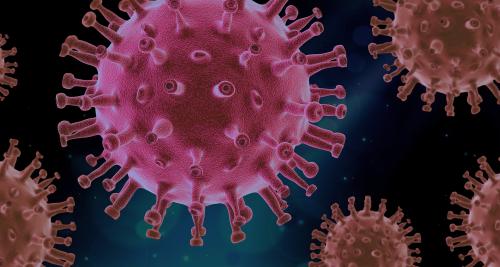Required Biosafety Levels
The following are general biosafety level requirements. Follow all EH&S and IBC requirements as communicated in your BUA Letter. Additional site-specific requirements may be required for certain facilities or shared laboratory spaces.
Summary of Minimum Required Biosafety Levels
| Virus, specimen, or activity | Biosafety level (BSL) | Agent listing on BUA letter | Occupational health requirement |
| SARS-CoV-2 in vitro and in vivo experiments | BSL-2 | SARS-CoV-2 | Requirement to offer the COVID vaccine |
| Clinical samples from COVID patients | BSL-2 | Human source material | None |
| SARS-CoV-2 nucleic acid and fixed/inactivated samples | BSL-1 | Not required to be listed | None |
Working with SARS-CoV-2 nucleic acids
When polymerase chain reaction (PCR) is used to amplify gene targets, large numbers of amplified nucleic acid molecules, or amplicons, are generated. Nucleic acid amplicons are not infectious or hazardous to human health. However, if not contained, amplicons can potentially contaminate surrounding surfaces and equipment, personnel and research experiments. Contamination is also possible when working with DNA and DNA products such as plasmid preparations.
If SARS‑CoV‑2 nucleic acid contamination reaches one’s nasal passages via inhalation or touching of one’s face with contaminated hands, COVID-19 nasal swab test results may be affected and return as positive or inconclusive, despite the individual not having an active SARS-CoV-2 infection at the time of testing. Such personnel may be asymptomatic with no known exposure to a COVID-19 positive individual.
If your lab uses polymerase chain reaction (PCR) to amplify SARS-CoV-2 gene targets or works with PCR product, plasmid preps or any nucleic acid from SARS-CoV-2, please review our Prevent and Manage Amplicon Contamination in Your Lab Focus Sheet.
SARS-CoV-2 classification updates
As of January 2025, the UW IBC has determined that most research with SARS-CoV-2 can be safely performed at BSL-2 in alignment with the changes from the CDC and NIH in December. More details are below. Certain experiments, such as those involving genetic modifications or other specific manipulations, may require BSL-3. Additionally, any deliberately manipulated SARS-CoV/SARS-CoV-2 chimeras with nucleic acids coding for SARS-CoV virulence factors are select agents and must comply with applicable select agent regulations.
In December 2024, the CDC (Centers for Disease Control and Prevention) has updated its biosafety guidance for work with SARS-CoV-2. The CDC now recommends that work with SARS-CoV-2 be conducted at a minimum of biosafety level 2 (BSL-2). The National Institutes of Health (NIH) is aligning by rescinding the interim risk group classification of Risk Group 3 for SARS-CoV-2. The NIH Guidelines now classify SARS-CoV-2 and most other human coronaviruses as Risk Group 2. (SARS-CoV and Middle East Respiratory Syndrome (MERS-CoV) remain classified as RG3 agents and require a minimum of BSL-3 for work.)
Emergency Response and Reporting
UW personnel are required to submit an incident report to Environmental Health & Safety for any work-related event that results in an injury, illness, exposure to hazardous materials, property damage, or fire, regardless of the work location. UW personnel are highly encouraged to submit work-related near-miss events. Visit the Incident Reporting page for more information.
Notify EH&S immediately (after first aid/medical care/emergency services) if the incident involves recombinant or synthetic nucleic acids or genetically modified organisms.
- During EH&S business hours: (8:00 a.m. to 5:00 p.m., Monday to Friday) call (206) 221-7770.
- Outside of EH&S business hours: call the UW Police Department at (206) 685-8973 to reach EH&S on-call staff.
More Information
Visit the EH&S COVID-19 Health and Safety webpage for the most current COVID-19 prevention policies and guidance.
